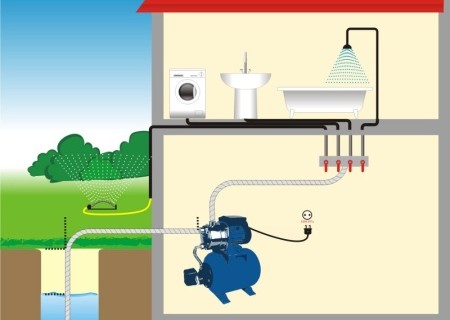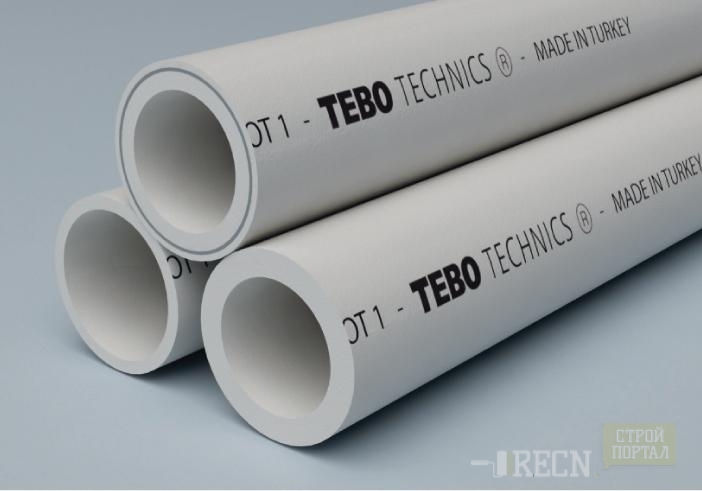
How to conduct a water pipe to the house. Installation of the water pumping station Construction

The material that is set out in this article contains all the necessary data for self-arrangement of the water supply in a private house. The supply is carried out from the ready-made well using the water station.
Content
Introduction
The dummy well in a private house or in the country area is very good and convenient. But for greater comfort, you can additionally install a special device that will pump water into the house from the well. The choice of a specific device depends on which depth is water. There are two main types of similar devices - submersible pumps and water stations. Submersible pumps are used when the water level is at a depth of more than 9-10 meters. If the distance to the water mirror does not exceed this mark, use pumping stations. Due to the fact that in the overwhelming majority of wells, the water level is less than 10 meters, for this water source, the pumping station is the optimal choice for water supply to the house. 
Pump station in a private house
Pumping station and her choice
The essence of the water station is quite simple. When it is turned on, through the hose, which is omitted to the well, the required water volume is pumped into the tank, after which the station is turned off. When the crane is opened, for example, in the kitchen, or in the bathroom, water under pressure goes to the crane. As you use, its level and pressure drops. Upon reaching a certain level, the station again automatically turns on by filling the reservoir. Cooling the station itself occurs due to the circulation of cold water. The water station for home is two species - vortex and centrifugal. The vortex stations are installed on the surface and operate due to the creation of pressure in the system using a paddle wheel. For their work, it is necessary initial pressure, which is achieved by the bay of water into the tank before the first starting station. The stations of this type have increased sensitivity to temperature drops, which is why it is recommended to be installed in closed and frost-protected rooms. The second version of the stations - centrifugal, in their work use pressure, which creates a centrifugal wheel of the pump. There are two types - submersible and semi-feed. In the first case, the pump is completely under water, in the second, can be placed above the water level. Basically, this option is used in all sorts of wells - drilling or artesian. Due to its constructive features, pumping stations of this type can withstand serious temperature differences in the water supply. 
Centrifugal pumping station
Choosing a variant of the pumping station for a home well, it is worth remembering that the centrifugal pumping stations create small twists during operation, as a result of which various particles from the bottom of the well can enter the water. The vortex stations are delivered from this, because the engine and pump are far from the source of water, and only the pipe is connected to the well. In addition, centrifugal stations must be installed in the well itself, which is not very convenient and quite difficult. The vortex station can be located anywhere, the main condition is normal temperatures, without sudden drops and no humidity. Based on this, it can be concluded that for a home well optimal option is to install a vortex type pumping station. 
Vortex station
The design of such a station is presented in two versions - with a tank and without it. The option without a tank is not very convenient, because without a stock of water, which is recruited into the tank (its volume can be different, depending on the model, often from 20 to 100 liters), the station will be constantly in operation, which will significantly reduce its service life . It is preferable to choose a variant with a tank that consists of two parts. The first is used to store water stock, and in the second injected air under pressure. Due to this, even when the electricity is disconnected, the station will be able to provide normal water supply due to pressure and water reserves.
By choosing a pumping station, such parameters should be taken into account:
1. Tank volume.
2. Power pump water station.
3. The height of the water lift and the distance to the well.
4. The material from which the housing and tank is placed is plastic, cast iron, stainless steel.
5. Operating pressure in the system - from 0.5 to 6 atmospheres.
6. Availability in a set of additional accessories, such as dry stroke sensor, cleansing filters, etc.
Also worth paying attention to the presence of the check valve. This valve will help prevent the "care" of water into the well when the station pump is turned off and protect it from turning on idle mode. In addition, an important element is an input filter, which will prevent foreign substances or dirt from entering the station.
Preparatory work and installation of the water station
Installation of the water station is performed after the construction of the well. Since the water station is susceptible to temperature drops, it is preferable to mount it in a house, for example in a basement or auxiliary room, the main thing is that there is no sharp temperature fluctuations. Special attention should be paid to the pipes. Modern pipes for water supply are presented on the market in a fairly wide assortment - galvanized, cast iron, steel, polymer and metal-plastic. Now the pipes for water supply from polymeric material are increasingly popular, which have a lot of advantages compared to counterparts - lightness and simplicity of installation, small weight, service life up to 70 years, affordable price. 
Polymer pipes
The outer water pipe is recommended to do from pipes and components of one brand, which will greatly facilitate the assembly process and improve tightness. Initially, there is a so-called, preparatory, rough stage - a ridge of trenches. The depth of the trench should be sufficient to ensure that the pipe does not laugh in the winter. The width is not so principled here, it is enough 30 - 50 cm, the main thing is to be convenient to work. If there is no possibility to pull out the trench on the necessary depth, you can pave along the pipe insulated cable, which will protect it from freezing. 
Trench for water pipes
With sufficient depth, it is necessary to insulate the pipe with a porpoil with a nozzle, and on top of putting a sheet of foam, a thickness of 2 to 4 cm, on top of which to fall asleep the land, periodically its ramming. When paving the pipe, it is necessary to ensure that the path from the station to the well was a small slope, not more than one degree. This will prevent the appearance of air traffic jams in the pipe. When entering a well, a hole is made at the passage level or drilled a hole sufficient for the free passage of the pipe, after which it is lowered into the well, so that its end is in water, by about 30-50 cm. This is enough enough to ensure Water supply. A mesh cleaning filter is installed on the end of the pipe. 
Tower
At the site of entering the pipe to the house, with the help of a special tool, a hole is made under the pipe, which is close to the cement and the mounting foam. The station itself is installed on a flat surface, which avoids vibration and shifts when working. If necessary, you can consolidate the station on the installed surface using special bolts;
Connecting the water station
Connecting the water station can not be called too complex process, here the main thing is to be attentive and follow the instructions. 
Total connection scheme
The workflow consists of such stages:
1) Installation of the pipeline, the pipe used for the connection should have a diameter of 25 or 32 mm. One end, it is connected to the plumbing hose, and the second to the inlet located at the station. It should also closely monitor the presence of a slope that should go towards water. The connection is performed using fittings. All connections should be tightly using a sealing flax for this or a fum-tape. Both means are good, the choice often depends on the personal preferences of the wizard or the availability of one or another material.
2) filling station with water
In no case can not be launched the "dry" station. This can lead to her breakdown, and the repair of the water station is quite expensive and troublesome. Before the first launch, you should fill it with water, which is poured inside through a special valve, located in most cases on the upper side of the station. The volume of water flooded may differ, depending on the brand and the type of station. Pour water should be slowly so that all the air left the system.
3) Maintenance Connection
At this stage, it is necessary to connect the station itself to its pressure section. To do this, the pipe (hose) is connected to the outer nozzle, which will be responsible for the supply of water inside the house. The compound is made similarly - with the help of fitting. At the beginning of the pipe, a crane is installed, with which it will be possible to overlap the water supply at the desired moment, without turning off the stations. As with the connection of the incoming highway for greater tightness and reliability use fum-tape or sealing flax.
4) Connecting the water station to the network
To ensure the most secure operation of the water station, a separate line is used. Choosing a socket, you should pay attention to the presence of protection in it, and choosing a wire, it is necessary to correctly select its cross section, which also depends on the type of station, its characteristics and power. After the connection works, the station should be triggered by filling out the main and tank with water. When the tank is filled, the station will automatically turn off. At this stage it is necessary to check the pressure in the system. The optimal is considered the figure in three atmospheres. If for some reason the pressure does not match the norm, it should be removed the relay cover and adjust the pressure using the control nut. With a larger pressure, it should be laid to the desired mark, and with insufficient pressure, pump up with the help of a car compressor or, as a last resort, the pump.
5) Checking the proper operation of the pump
After automatically disconnecting the pump, you should open a tap with water and give it a little drain. After the water volume in the tank decreases, and the pressure in the system will fall accordingly, the station will automatically turn on.
This is the installation of an aquatic station, and its commissioning is completed. Everything that remains is to enjoy comfort and use water in the house.


















